The AMD 2nd Gen Ryzen Deep Dive: The 2700X, 2700, 2600X, and 2600 Tested
by Ian Cutress on April 19, 2018 9:00 AM ESTPrecision Boost 2 and XFR2: Ensuring It Hertz More
One of the biggest changes for the new Ryzen-2000 series is in how the processor implements its turbo. Up until this point (except the recent APU launch), processors have relied on a step function implementation: the system determines how many threads are loaded, attempts to implement a specific frequency on those cores if possible, and then follows the look-up table relating thread count to frequency. AMD’s goal in Precision Boost 2 is to make this process more dynamic.
This image from AMD is how the feature is being represented: the system will determine how much of the power budget is still available, and turbo as much as possible until it hits one of the limiting factors. These factors can be any of, but not limited to, the following:
- Total chip peak power
- Individual core voltage/frequency response
- Thermal interactions between neighboring cores
- Power delivery limitations to individual cores/groups of cores
- Overall thermal performance
AMD’s new Ryzen Master 1.3 software, when used on a Ryzen 2000-series processor, has several indicators to determine what the limiting factors are. For the most part, the way the processor will boost and respond to the environment, will be transparent to the user.
The best way to test this in action, from my perspective, is to look at the power draw of the first generation and second generation Ryzen processors. We can examine the internal estimated power consumption of each core individually as thankfully AMD has left these registers exposed, to give the following data:
This is only the core consumption power, not the package power, which would include the DRAM controller, the Infinity Fabric, and the processor IO. This means we get numbers different to the rated TDP, but the danger here is that because the Ryzen 7 2700X has a 10W TDP higher than the Ryzen 7 1800X, where the 2700X draws more power it could seem as if that is the TDP response.
Just plotting the power consumption gives this graph:
Even in this case it is clear that the Ryzen 7 2700X is drawing more power, up to 20W more, for a variable threaded load. If we change the graph to be a function of peak power:
The results are not quite as clear: it would seem that the 1800X draws, as a percentage of peak power, more at low thread count, but the 2700X draws more at a middling thread count.
It is worth noting that the end result of Precision Boost 2 is two-fold: more performance, but also more power consumption. Users looking to place one of the lower powered processors into a small form factor system might look at disabling this feature and returning to a standard step-function response in order to keep the thermal capabilities in check.
A side note – despite the marketing name being called ‘Precision Boost 2’, the internal BIOS name is called ‘Core Performance Boost’. It sounds similar to Multi-Core Enhancement, which is a feature on some Intel motherboards designed to go above and beyond the turbo mechanism. However, this is just AMD’s standard PB2: disabling it will disable PB2. Initially we turned it off, thinking it was a motherboard manufacturer tool, only to throw away some testing because there is this odd disconnect between AMD’s engineers and AMD’s marketing.
Extended Frequency Range 2 (XFR2)
For the Ryzen 2000-series, AMD has changed what XFR does. In the previous generation it was applied on certain processors to allow them to boost above the maximum turbo frequency when the thermal situation was conducive to higher frequencies and higher voltage in low thread-count states. For this generation, it still relates to thermals, however the definition is applied to any core loading: if the CPU is under 60ºC, the processor can boost no matter what the loading is above its Precision Boost 2 frequency (so why not get a better PB2 implementation?). The core still has to be within a suitable voltage/frequency window to retain stability, however.
On certain motherboards, like the ASUS Crosshair VII Hero, there are additional options to assist XFR2 beyond AMD’s implementation. ASUS does not go into specific details, however I suspect it implements a more aggressive version, perhaps extending the voltage/frequency curve, raising the power limits, and/or adjusting the thermal limit.


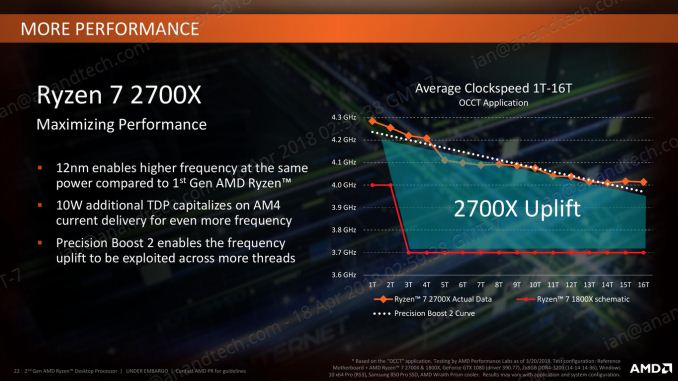
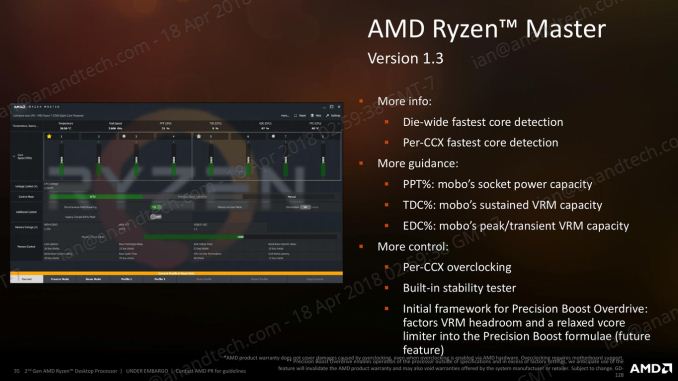

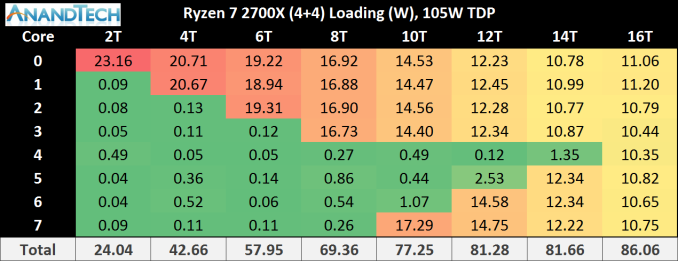
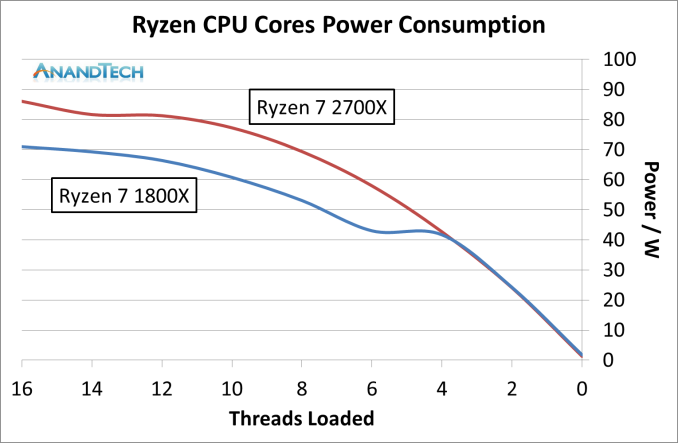
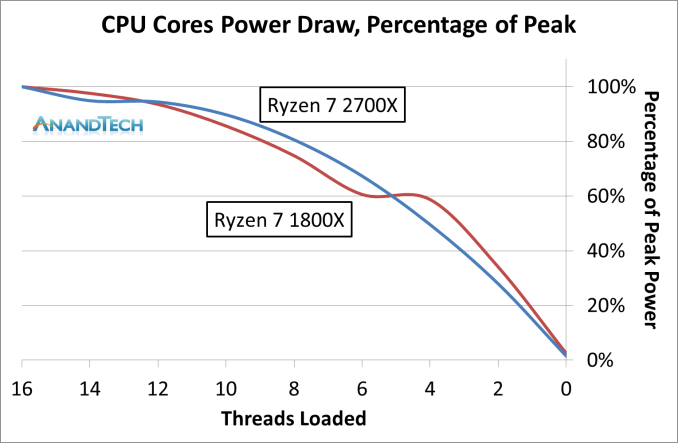
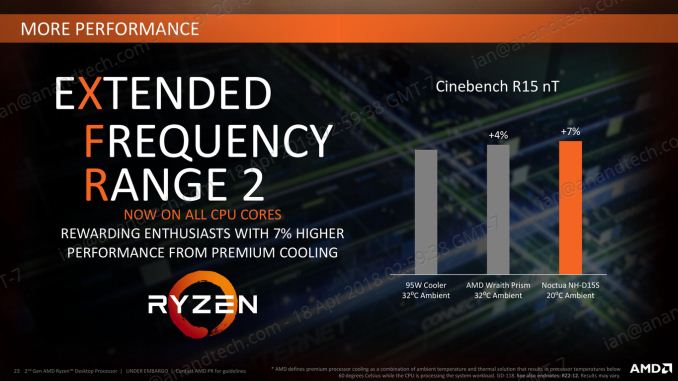








545 Comments
View All Comments
Santoval - Thursday, April 19, 2018 - link
It's possible that the first consumer Intel 8-core will be based on Ice Lake. Cannon Lake will probably largely limited to low power CPUs, and will probably top out at 4 cores. Of course if Ice Lake is delayed again Intel might scale out Cannon Lake to more cores. Cannon Lake will be just a 10nm node of the Skylake/Kaby/Coffee Lake architecture, so it will most likely provide mostly power efficiency gains.aliquis - Thursday, April 19, 2018 - link
Latest road map show coffee lake refresh in Q4.mahoney87 - Thursday, April 19, 2018 - link
lol :Dhttps://imgur.com/SmJBKkf
They done fecked up
Luckz - Monday, April 23, 2018 - link
Rocket League is a joke game when it comes to benchmarking, optimization and so on.Chris113q - Thursday, April 19, 2018 - link
Do you really need to be spoon-fed information? How long would it take you to find the other reviews by yourself?PCPER, Tweaktown, Toms Hardware, Hothardware, Computerbase all had different results (can't post link due to spam protection). Not to mention you'd have to be totally tech illiterate to believe that stock 2600 can beat 8700k by such a huge margin. Meltdown/Spectre patches don't affect gaming performance that much, so don't you put blame on that.
The result discrepancy is embarrassing, there goes the last speck of reputation Anandtech had as a reliable source of tech news.
MuhOo - Thursday, April 19, 2018 - link
You sir are right.Aegan23 - Thursday, April 19, 2018 - link
You do know who Ian is, right? XDsor - Thursday, April 19, 2018 - link
Anandtech has no responsibility to go out and ensure their results match up with anyone else’s. They run their own selection of tests with their own build and report the numbers. They provide the test setup, if you can’t spot the differences that’s your own issue.Ryan Smith - Thursday, April 19, 2018 - link
"Anandtech has no responsibility to go out and ensure their results match up with anyone else’s"Responsibility? No. But should we anyhow? Yes.
Our responsibility is accuracy. If something looks weird with our data - which it does right now - then it's our job to go back, validate, and explain the results that we're seeing. If our results disagree with other sites, then that is definitely an indication that we may have a data issue.
xidex2 - Thursday, April 19, 2018 - link
I bet none of the other sites applied spectre and meltdown patches for Intel because they dont care about such things. Intel fanboys are now crying because someone actually showed true numbers.